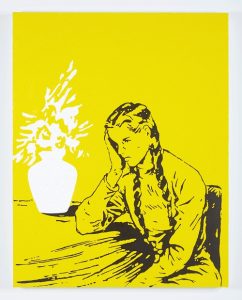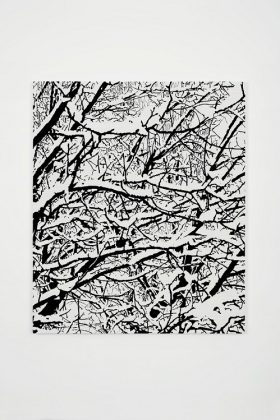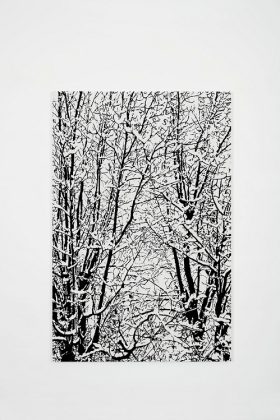By Kayhan Life Staff
Farhad Moshiri, one of Iran’s most prominent and successful contemporary artists, died this week at the age of 61. His dealers, Galerie Perrotin in Paris, confirmed the death. He passed away of a heart attack in Tehran, according to news agency reports.
Moshiri made international headlines in March 2008 when, at a Bonhams sale in Dubai, he became the first Middle Eastern artist to have a contemporary work auctioned for more than $1 million. “Eshgh” (2007) consisted of a large black canvas with the Persian word for love embroidered on it with Swarovski crystals.

© Photo: Guillaume Ziccarelli
Courtesy Perrotin
The artist was even better known for his paintings of Persian jars: old clay containers which once contained vinegar or wine and which he bought from a market.
He was married to the fellow Iranian Pop artist Shirin Aliabadi, who sadly passed away in 2018.
In 2017, he had his first solo museum exhibition at the Andy Warhol Museum in Pittsburgh, Pennsylvania. “Farhad Moshiri: Go West” was a mid-career survey that juxtaposed tradition with the strong appeal of Western popular culture in Iran.
“This exhibition introduces Farhad Moshiri to new audiences and presents him as one of the most important contemporary artists based in Iran,” said the Warhol Museum’s chief curator José Carlos Diaz at the time.
The previous year, Moshiri had a wide-ranging conversation with Kayhan Life, when he was in London to launch an illustrated two-volume catalogue of his work – “Life is Beautiful,” edited by Dina Nasser-Khadivi and published by Skira.
Moshiri remembered spending his childhood and adolescence in Shiraz, where his father owned a chain of movie theaters. “I should have been a filmmaker,” he said. “I was raised watching more films than art books.”
In parallel, he studied painting from a young age, first at school in Shiraz, and then in the 1980s, when he moved to the US to study at the California Institute of Arts.
It was not an easy time to be in the U.S. “Iran was very detached from the world,” Moshiri recalled. “It was portrayed in a very dark and nasty way.” And after graduation, Mr. Moshiri’s career did not go as well as he hoped: “It was very difficult to find work as an artist. I had a show, but it was not very successful.”
So after 13 years away from his homeland, Mr. Moshiri moved back to Iran, and “left any thought of being an artist behind.” Why? “I was going back to a place where the art world didn’t exist. I couldn’t make it in the West. How could I make it in Iran?”
Returning to Shiraz, he began by making design objects – chairs, tables and other household items that he found in reject shops and restored – and selling them. It was a frustrating enterprise for the artist, because he realized that no matter how hard he painted or drew over a chair, it was still “just a chair” and not a work of art. So he “went canvas: I started to paint again.”

2014.© Photo: Guillaume Ziccarelli. Courtesy of the artist and Perrotin
Those early canvases were “really bad,” he recalled. Yet they gave him a refreshing sense of freedom, and allowed him to experiment with “no one watching.”
Eventually, he started to produce naïve paintings inspired by Qajar art, and a couple of years after his return to Iran, he got his first exhibition at the Seyhoun Gallery in Tehran (where he lived and worked).
Moshiri was still convinced that film was his true calling; it was a discipline he had studied at Cal Arts, and he was heartened by the success of Iranian cinema in the West. So he continued to work with the camera. To get unexpired negative stock, he had to go through state-run institutions such as the Farabi Foundation and submit his scripts before he could begin filming. The scripts repeatedly came back for revision. “It was an endless cycle of meetings,” said Mr. Moshiri, who came to the realization that cinema was a “controlled” medium.
Painting was much easier: “I could paint with nobody looking over my shoulder.” After a few early assemblage paintings – composed of found materials such as a door, a torn carpet, a window, a piece of wood – he began taking an interest in ancient Iranian art and archaeology.

Beads and acrylic on canvas on board / Perles et acrylique sur toile
190 x 150 cm | 74 3/4 x 59 1/16 inches
© Photo: Guillaume Ziccarelli
Courtesy of the artist and Perrotin
Shopping around the markets with his artist wife Shirin Aliabadi, he came across tired old jars in which vinegar and wine were once made, and started buying them for the equivalent of a few dollars each. One day, as he carried one in the trunk of his car, he was stopped by officers who were convinced he was transporting a priceless object.
From that point on, “I just started painting the jar, and tried to imitate what I liked about it on a flat surface.” Mr. Moshiri’s jar canvases started selling extremely well, and his market took off – first at home, then in Europe. Moshiri went on to make paintings with Persian calligraphy and numbers, then changed tack completely to chronicle tastes in contemporary Iran and produce a kind of Iranian Pop Art.
“Something was happening in society that was very fascinating: the nouveau riche aesthetic,” he said. “Petrodollars were starting to trickle down, people were building, stuff was happening.” Producing exaggerated portrayals of the homes of the newly rich, which were filled with faux baroque furniture, Mr. Moshiri created a series of ultra-ornate sculptural installations that covered chairs, tables, and home entertainment systems in a deliberately gaudy, shiny gold.
Mr. Moshiri’s Rome gallerist then suggested that he produce art that could hang on walls. Remembering the framed embroideries that were found in so many Iranian homes, he made embroidery his new medium – working with professional embroiderers, all of whom were women: “I liked the fact that I was being soft and feminine,” he noted. The embroideries grew in size and became more lavish, incorporating materials such as crystal. Out of that series came the famous “Eshgh” work, and Mr. Moshiri’s global success.
Why did Eshgh make such a splash in Dubai? Because it was a moment in which the auction houses came to the Middle East looking for indigenous art. “There was no real database where they could find artists, so they would ask around to see who had a show, who made noise here and there, and they would do studio visits.”
“We were just lucky to be there, and it happened at the height of the excitement around Dubai,” Mr. Moshiri explained
Since then, “it’s been a challenge for me to keep up and not repeat myself,” says the artist. “So I’m constantly trying to develop new ideas, new ways, new methods.”
As for the flourishing of contemporary art in Iran, he welcomed it with open arms. “We can’t be too harsh on something that never had a chance, and now that it’s sort of having a chance, crush it,” he said. “I think it’s all good.”





